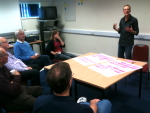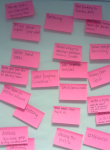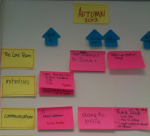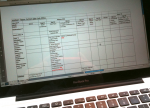 I have just returned from a meeting that is very relevant to this series. So, contrary to what I had anticipated in this posting, I am going to share my experiences as they illustrate what this series is about and how powerful the process of Facilitation can be.
I have just returned from a meeting that is very relevant to this series. So, contrary to what I had anticipated in this posting, I am going to share my experiences as they illustrate what this series is about and how powerful the process of Facilitation can be.
What is Jubilee+?
I was invited to attend the two-day retreat of the Core Team of Jubilee+ where they were seeking God about their strategy for the next season. Their intention was to end up with an Action Plan. Jubilee+ is an initiative within the UK for facilitating Newfrontiers churches (and others) to launch effective ministry among those who are poor and disadvantaged.
What did we do?
 One of the team members, Andrew Westerman (Emmanuel Church, Durham and Kairos UK Ltd) served the Team as facilitator, a skill in which he is highly gifted. There were several stages.
One of the team members, Andrew Westerman (Emmanuel Church, Durham and Kairos UK Ltd) served the Team as facilitator, a skill in which he is highly gifted. There were several stages.
1. Dreams
Following an extended time of prayer Andrew invited us to dream. What would we like to see? What words came to mind that needed discussion?
 This process of ‘blue-sky’ thinking, not feeling trapped by pre-supposition, is a valuable part of getting a group to work together. We had already established some ground rules for our time – another important part of the process – where we agreed such ‘rules’ as ‘Accept everything (ie suggestions) discuss nothing (at that stage)’. This gives security that what I have to offer is valid alongside thoughts of my colleagues. Another: ‘Headlines only’; this was not the time for long-winded explanation.
This process of ‘blue-sky’ thinking, not feeling trapped by pre-supposition, is a valuable part of getting a group to work together. We had already established some ground rules for our time – another important part of the process – where we agreed such ‘rules’ as ‘Accept everything (ie suggestions) discuss nothing (at that stage)’. This gives security that what I have to offer is valid alongside thoughts of my colleagues. Another: ‘Headlines only’; this was not the time for long-winded explanation.
Andrew recorded each suggestion on a Post-it. These were then analysed by him and two main topics were identified for further discussion.
2. World café
 To facilitate discussion we were divided into two groups. Each group was given one topic to begin, and then changed places to discuss the second topic. This took place around tables with ‘write on’ table cloths so that each person could record his or her contribution in a coloured pen. (One person remained at each table for both discussion periods to help continuity.)
To facilitate discussion we were divided into two groups. Each group was given one topic to begin, and then changed places to discuss the second topic. This took place around tables with ‘write on’ table cloths so that each person could record his or her contribution in a coloured pen. (One person remained at each table for both discussion periods to help continuity.)
At the end of the second round-table discussions the groups were asked to highlight the key features that arose from the notes on the cloths. These were used to guide part 3 of the process.
3. Creating an Action Plan
 Using Post-its a timeline was created along a blank wall. Key events were then positioned under the relevant months.
Using Post-its a timeline was created along a blank wall. Key events were then positioned under the relevant months.
Andrew had taken the ‘dream’ topics and grouped them in categories, each to be placed on a row under the timeline: Core Team, Communication, Training etc. At this point each ‘dream’ was discussed more fully. Was it relevant? Should it be carried out? When and how? Who should be taking the lead for putting it into action?
4. Capturing the action Plan
 During this process various flip charts were used as appropriate. Photos were taken of each stage. As a result all had been recorded and, after the team dispersed, it was possible to lay out the action plan on a spreadsheet, which will be used as the basis for monitoring progress in the months ahead.
During this process various flip charts were used as appropriate. Photos were taken of each stage. As a result all had been recorded and, after the team dispersed, it was possible to lay out the action plan on a spreadsheet, which will be used as the basis for monitoring progress in the months ahead.
The whole process was both stimulating and enjoyable – as well as being productive! In the next blog I will revert to my earlier intention of addressing some of the practicalities associated with carrying out facilitation, some of which have been demonstrated above.
